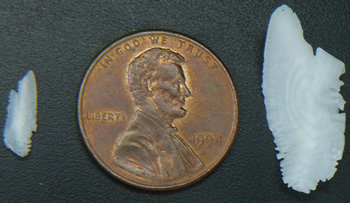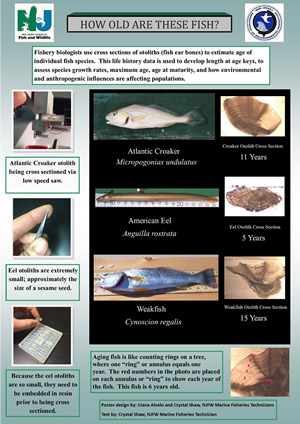 |
A Day in the Chem Lab:
Aging Weakfish, Atlantic Croaker, and American Eels |
|
by Crystal Shaw, Hourly Fisheries Technician
Bureau of Marine Fisheries
September 26, 2016
Have you ever participated in a fishing tournament and brought your catch to a weigh-in station? If so, you may have encountered employees with the Division of Fish and Wildlife's Bureau of Marine Fisheries documenting the weight and length of your fish, or even placing the head from a recently filleted fish carcass into one of their coolers. To most people, fish heads may only seem useful at the bottom of a crab pot, but a fishery biologist knows that within these heads are anatomical structures that can provide useful data for ongoing species population studies.
|
The portion most commonly harvested from fish for aging purposes are the otoliths. Frequently referred to as "earstones", otoliths are hard, calcium carbonate structures that float beneath the brain inside the inner ear canals1. They assist the fish with balance, orientation, and sound detection2. Once an otolith is extracted from a fish's skull it can be processed for aging. This involves taking a cross section of the otolith in order reveal a series of translucent bands and opaque rings. These are then counted in the same manner as one would to age a tree.
At Fish and Wildlife's Nacote Creek Research Station in Port Republic, otoliths are processed and aged for Anguilla rostrata (American eel), Micropogonias undulates (Atlantic croaker), and Cynoscion regalis (weakfish). American eel otoliths are extracted from eels that have been purchased from local commercial fisheries at market value, while Atlantic croaker and weakfish otoliths are extracted from fish that have been collected during commercial sampling. Additional Atlantic croaker and weakfish otoliths are also obtained by sampling during other field surveys. (See the article, A Day On the Ocean Trawl.)
|
|
Once all the otoliths for each species are collected, they are processed at the Nacote Creek Research Station's chem lab. The protocol for processing Atlantic croaker and weakfish otoliths involves using a low-speed saw to obtain three cross sections through the core of the otolith. These cross sections are then mounted to a microscope slide with a clear adhesive and once the adhesive is dry the otolith is ready to be aged.
For the American eel otoliths, the procedure is a bit more complex. Due to these otoliths being very small (approximately 1mm in length), the otolith needs to be embedded in a mold of epoxy resin prior to cutting the cross section. After the epoxy is left to dry overnight, a single cross section through the otolith core is made. The cross section is then mounted to a microscope slide with an adhesive and then polished with a series of micron lapping films (very fine sandpaper).
Once polishing is complete, the cross section needs to be prepared for staining. To do this, the slide is soaked in a solution of Ethylenediaminetetraacetic acid (EDTA) followed by a soaking in a solution of toluidine blue stain. The EDTA binds to calcium in the otolith (translucent bands), which further assists the protein in the opaque rings to absorb the stain. Once the stain is absorbed the otolith is ready to be aged.
Preparing otoliths for aging can be a long and tedious process but it is important that each step is carried out carefully. The better the cross section, the greater the accuracy of the aging of the otolith.
|
|
When researchers age a sample of fish for the year, or over a period of years, the data provides life history information that include growth rates, maximum age, fecundity, and age at maturity3. Even environmental and anthropogenic stressors that may be affecting fish populations can be identified by variations in growth ring sizes within an otolith4, 5. This data is recorded and used in statistical analyses to aid in successful management of recreationally and commercially harvested populations of fish. All this information is provided by two little bony structures in a fish's head that most people don't even know exist!
REFERENCES
1 Green BS, Mapstone BD, Carlos G and Begg GA. 2009. Tropical Fish Otoliths: Information for Assessment, Management and Ecology. Springer.
2 Popper AN, Fay RR. 1993. Sound detection and processing by fish: critical review and major research questions. Brain Behav Evol 41:14-38.
3 Jackson J. 2007. Earliest references to age determination of fishes and their early application to the study of fisheries. Fisheries History. Fisheries. Vol 32:7.
4 Casselman JM. 1990. Growth and Relative Size of Calcified Structures in Fish. Transactions fo the American Fisheries Society. Vol 119:4.
5 Pannella G. 1971. Fish otoliths: daily growth layers and periodical patterns. Science, New York 173: 1 124-1 127.
|
Back to A Day In the Life Of a Marine Fisheries Hourly
|


